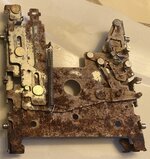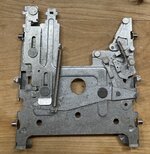s_pupp
Well-known member
I spent the last few days working on the stack of eBay crusty junk (the seller's very accurate description) 1.4MB floppy drives in my possession.
I'm going to show pictures of the one that was in the worst condition. There was so much corrosion on this one that the carriage mechanism was frozen.
The method I used to restore the crusty mechanisms to working condition:
- scrubbed the most rusty bits with a brass brush to get rid of loose rust, then washed it in tap water and dried with a microfiber cloth
- soaked them in Evaporust for 24 hours
- scrubbed them with a stiff bristle brush which got rid of some of the dark discoloration of the metal that was present after the Evaporust treatment
- washed the Evaporust off with tap water and dried the mechanisms with a microfiber cloth
- placed them for several minutes in a tub of Corrosion-X which, according to its website, "disrupts rust and corrosion on the molecular level (displacing it from the metal surface and keeping it from spreading), and provides long-term protection against rust and corrosion on any metal surface." It also has lubrication properties.
While the other less-crusty drives looked better than this after treatment, the improvement was, nonetheless, satisfying. The mechanism feels smooth.
One nice thing about Evaporust is that you can pour the used liquid back into the bottle and reuse it. It'll work just fine until completely saturated.
Information online about the use of Corrosion-X suggests that it is not harmful, but the MSDS and label on the bottle read like the disclaimers for "Happy Fun Ball." I got the impression that one should have a Hazmat suit on, and 911 cued up on the phone. I used gloves and had the room ventilated. Since the items put into the tub are clean, I poured the remainder back into the bottle for use with the next batch of floppy drives.
Because the amount of Evaporust and Corrosion-X used is small, this was an inexpensive treatment.
I'm going to show pictures of the one that was in the worst condition. There was so much corrosion on this one that the carriage mechanism was frozen.
The method I used to restore the crusty mechanisms to working condition:
- scrubbed the most rusty bits with a brass brush to get rid of loose rust, then washed it in tap water and dried with a microfiber cloth
- soaked them in Evaporust for 24 hours
- scrubbed them with a stiff bristle brush which got rid of some of the dark discoloration of the metal that was present after the Evaporust treatment
- washed the Evaporust off with tap water and dried the mechanisms with a microfiber cloth
- placed them for several minutes in a tub of Corrosion-X which, according to its website, "disrupts rust and corrosion on the molecular level (displacing it from the metal surface and keeping it from spreading), and provides long-term protection against rust and corrosion on any metal surface." It also has lubrication properties.
While the other less-crusty drives looked better than this after treatment, the improvement was, nonetheless, satisfying. The mechanism feels smooth.
One nice thing about Evaporust is that you can pour the used liquid back into the bottle and reuse it. It'll work just fine until completely saturated.
Information online about the use of Corrosion-X suggests that it is not harmful, but the MSDS and label on the bottle read like the disclaimers for "Happy Fun Ball." I got the impression that one should have a Hazmat suit on, and 911 cued up on the phone. I used gloves and had the room ventilated. Since the items put into the tub are clean, I poured the remainder back into the bottle for use with the next batch of floppy drives.
Because the amount of Evaporust and Corrosion-X used is small, this was an inexpensive treatment.


